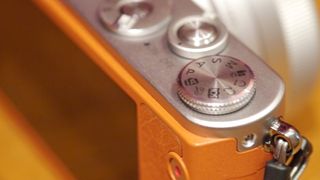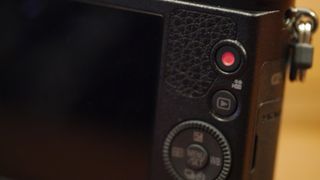Why you can trust TechRadar
The original point of the Micro Four Thirds design was that incredibly small cameras could be produced. Up until now, although we have seen some very small designs, none of them truly match the GM1, which almost needs to be seen to be believed. Coupled with the very small 12-32mm lens, this is a coat-pocketable device, if not yet a jeans-pocketable one.
Before you can use the camera, you'll need to first rotate the zoom ring of the 12-32mm lens. This means that it's not ready to shoot from switching on, but it does give the camera the advantage of collapsing down to a very small size. If you're carrying the camera outside a pocket, you can always leave the lens extended when not in use.
Although it has a touchscreen, there's still a satisfying number of dials and buttons on the body itself, especially when you consider its small size. On top of the camera is a dial for switching between the various exposure modes on offer, including aperture priority and shutter priority. There's also a dial for switching between different focusing modes: single, continuous and manual.

There is no dedicated dial for altering aperture or shutter speed, but, depending on the mode you're shooting in, you can make changes to these settings via the scrolling dial on the back of the camera. It seems likely that a large majority of the people using this camera will use it in fully automatic mode, but it's great that full manual control is available for those who want to experiment further down the line.
These dials, combined with the black and silver design, give it a classic, retro feel that will surely be appreciated by many style-conscious photographers.

On the back of the camera, the three-inch touchscreen is joined by the traditional four-way navigational pad, a menu button, a playback button, a movie record button and a trash button. You can control most elements of the camera via the touchscreen itself, but it's nice to have real buttons to use as well for those who prefer it, or those who'd rather use a combination of the touchscreen and buttons.
One slight downside of the camera's small size is that it can be quite easy for a thumb to stray into the touchscreen area, and therefore make the odd change to settings.
You can also use the touchscreen to set the autofocus point, and if you like, to fire off the shutter release. Both are very convenient features when you need them, and make the workflow of using the camera much quicker than those cameras without a touchscreen.
A quick menu is available for accessing commonly used settings, saving you having to dive into the full menu. The button marked with the trash icon is used to reach the quick menu when in shooting mode. From here, you can either use the touchscreen to move around the menu, or the four way navigational pad, or of course, a combination of both. Here you'll find parameters such as Photo Style, image ratio, flash and AF mode. It's possible to customise the Quick Menu if you have a particular setting you wish to access often.
There is also a customisable function button on top of the camera. By default this is set to access Wi-Fi functions, which seems like a sensible option. You can change it though, if you'd prefer something else. There are more 'virtual' function buttons, which can be accessed via the touchscreen, and these are also customisable.
Amy has been writing about cameras, photography and associated tech since 2009. Amy was once part of the photography testing team for Future Publishing working across TechRadar, Digital Camera, PhotoPlus, N Photo and Photography Week. For her photography, she has won awards and has been exhibited. She often partakes in unusual projects - including one intense year where she used a different camera every single day. Amy is currently the Features Editor at Amateur Photographer magazine, and in her increasingly little spare time works across a number of high-profile publications including Wired, Stuff, Digital Camera World, Expert Reviews, and just a little off-tangent, PetsRadar.

Devil May Cry creator on making a super gothic Netflix anime series: 'Infusing comedy within action really makes it pop'

Worried about EV longevity? These 5 electric cars have all done over 200,000km on their original battery

AMD's powerful Ryzen AI Max processors are on their way to desktop PCs - and a side effect could kill off discrete GPUs for gaming











